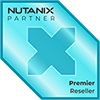
Nutanix Acropolis
Distributed Storage System for All of Your Workloads

Overview
Nutanix Acropolis combines compute, storage, networking, virtualization, and much needed data protection and security capabilities into a hyperconverged solution that powers your enterprise cloud. Eliminate storage silos, expensive virtualization technology, and dedicated management. Achieve operational agility while retaining your ability to choose your hardware and virtualization technology.
Scalable, Resilient, High Performance Distributed Storage for All of Your Workloads
Move beyond the limitations of traditional SAN and NAS storage. Nutanix AOS is the scale-out storage technology that makes HCI possible, delivering enterprise-grade capabilities via a highly distributed software architecture.

Powerful Enterprise Storage Capabilities for All of Your Data
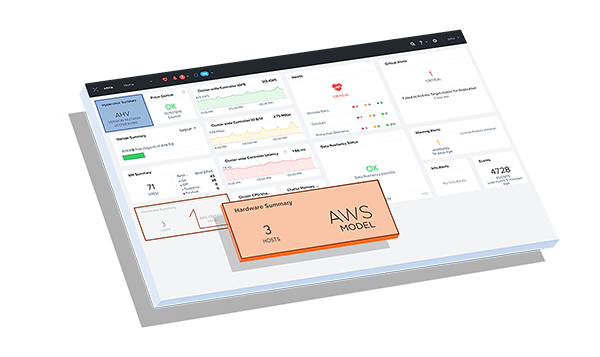
High performance storage system
Distributed data processing and local access to modern high performance storage media like NVMe and Optane drive high bandwidth and low latency that won’t degrade over time.
Resilient and secure storage platform
Utilizing advanced distributed software algorithms, AOS Storage protects data against everything from bit rot and hardware failure to physical theft and total site failure.
Flexible and scalable cloud infrastructure
Easily size and deploy infrastructure at any scale, for any workload, and scale out quickly. Mix and match hardware configurations seamlessly, so you can adapt over time.
Key Components:
Nutanix Acropolis has 5 key components that make it a complete solution for delivering any infrastructure service:
Built-in AHV Virtualization
Nutanix Acropolis includes AHV, our native virtualization solution, and additionally supports the virtualization solutions of VMware ESXi, Microsoft Hyper-V and Citrix XenServer. Nutanix AHV is a comprehensive enterprise virtualization solution tightly integrated into Acropolis and is provided with no additional license cost. AHV delivers the features required to run enterprise applications, for example:
- Combined VM Operations and Performance Monitoring via Nutanix Prism
- Backup, Disaster Recovery, Host and VM High Availability
- Dynamic Scheduling (Intelligent placement and resource contention avoidance)
- Broad Ecosystem Support (Certified Citrix Ready, Microsoft Validated via SVVP)
Platform Services
Nutanix Acropolis delivers a comprehensive set of software-defined platform services so that IT organizations can consolidate all their workloads on the Nutanix platform and manage them centrally. The use cases include:
- VM-centric storage to support almost any virtualized application
- Container Centric storage with persistent storage support for Kubernetes and Docker.
- Acropolis Block Services (ABS), a native block storage solution, for physical applications
- Acropolis File Services (AFS), a native file storage solution for unstructured data such as large-scale home directories, user profiles and more.
Enterprise Storage Capabilities
Nutanix Acropolis employs MapReduce technology to deliver highly distributed Enterprise grade storage to ensure no single points of failure and negligible impact to real-time performance. Nutanix Enterprise Storage capabilitie include, but are not limited to:
- Performance acceleration capabilities such as caching, data tiering & data locality
- Storage optimization technologies, such as De-dupe, Compression & Erasure Coding
- Data protection technologies to support snapshots to local, remote and cloud based sites
- Disaster Recovery features, such as, synchronous, asynchronous, and near-synchronous replication.
Networking Services
Nutanix Acropolis provides a comprehensive set of services to visualize the network, automate common network operations and secure the network through native services and partner integration. These services include, but are not limited to:
- Application-centric visualization of the physical and virtual network topology to instantly diagnose and fix common networking issues.
- Open APIs that enable network devices and services such as top-of-rack switches, application delivery controllers (ADC) and firewalls to automatically adapt based on application lifecycle events.
Enterprise Cloud is the Future of IT
World’s most advanced data-centers rely on Nutanix technology and solutions to power their workloads at any scale. It’s time for businesses to move away from legacy infrastructure. Eliminate the need for stand alone SAN or NAS-based storage and expensive virtualization and mitigate complexity and silos. Let Enterprise Cloud enable the possibility to run applications in the right environment at the right time.
Software Editions:
Acropolis is available in several editions to fit your datacenter needs.
| STARTER | PRO | ULTIMATE | |
|---|---|---|---|
| Core set of software functionality | Rich data services, resilience and management features | The full suite of Nutanix software capabilities to tackle complex infrastructure challenges | |
| Ideal For | Small-scale deployments with a limited set of workloads | Running multiple applications or large-scale single workload deployments | Multi-site deployments and advanced security requirements |
| Enterprise Storage | |||
| Cluster Size | 12 | Unlimited | Unlimited |
| Heterogeneous Clusters | |||
| VM-centric Snapshots & Clones | |||
| Data Tiering | |||
| Inline Compression | |||
| Inline Performance Deduplication | |||
| Online Cluster Grow/Shrink | |||
| Acropolis Container Services | |||
| Acropolis Block Services | |||
| Acropolis File Services | Standalone license available | Standalone license available | |
| MapReduce Compression | |||
| MapReduce Deduplication | |||
| Erasure Coding (EC-X) | |||
| VM Flash Mode | |||
| Infrastructure Resilience | |||
| Data Path Redundancy | |||
| Tunable Redundancy Factor | 2 | 2 or 3 | 2 or 3 |
| Availability Domains | |||
| Data Protection | |||
| Disaster Recovery with Async Replication (1hr or larger RPO) | |||
| Application Consistent Snapshots | |||
| Local Snapshots | |||
| Self Service Restore | |||
| Cloud Connect | |||
| Multiple Site DR (many to many) | |||
| Metro Availability | |||
| Disaster Recovery with NearSync or Sync Replication (1min-1hr RPO or 0 RPO) | |||
| Security | |||
| Client Authentication | |||
| Cluster Lockdown | |||
| Data-at-Rest Encryption (SED and Software Based) | |||
| Management & Analytics | |||
| Prism Starter | |||
| Pulse | |||
| Cluster Health | |||
| One-click Upgrades (Nutanix OS & Hypervisor) | |||
| Rest APIs | |||
| Supported Hypervisors | |||
| Nutanix AHV | |||
| VMware ESXi | |||
| Microsoft Hyper-V | |||
| XenServer for Citrix workloads | |||
| Built-In Virtualization (Nutanix AHV) | |||
| VM Management | |||
| Intelligent VM Placement | |||
| VM Automated Resource Scheduling | |||
| VM Affinity Rules | |||
| Virtual Network Configuration | |||
| Host Profiles | |||
| VM High Availability | |||
| Open Stack Drivers | |||
| Hypervisor Conversion | |||
| Cross Hypervisor DR | |||
| Self Service Portal | |||
Hyperconverged Platform:
Virtualization
Powerful, secure built-in virtualization that eliminates expensive hypervisor lock-in
An open platform for virtualization and application mobility
Nutanix Acropolis hyperconverged infrastructure supports customer choice in virtualization solutions including VMware vShpere (ESXi), Microsoft HyperV, Citrix XenServer, and Nutanix AHV. Nutanix AHV is a license-free virtualization solution included with Acropolis that delivers enterprise virtualization ready for a multi-cloud world. With Acropolis and AHV, virtualization is tightly integrated into the Enterprise Cloud OS rather than being layered on as a standalone product that needs to be licensed, deployed and managed separately. Common tasks such as deploying, cloning and protecting VMs are managed centrally through Nutanix Prism, rather than utilizing disparate products and policies in a piecemeal strategy.
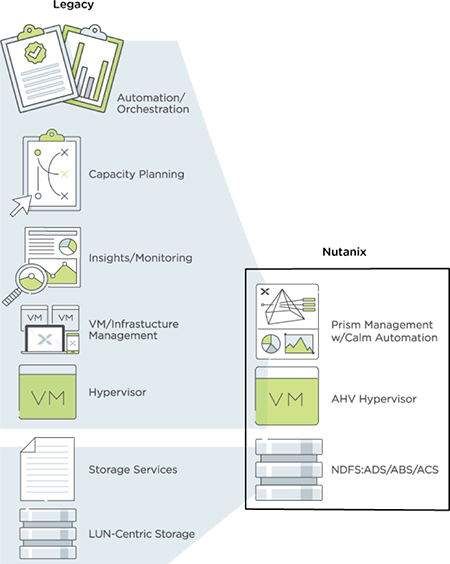 Native Virtualization
Native Virtualization
Nutanix AHV is an enterprise-class virtualization solution included with the Acropolis Enterprise Cloud OS, with no additional software components to install and manage. Starting with proven open-source virtualization technology, AHV combines an enhance data path for optimal performance, security hardening, virtual networking, and enterprise virtualization management features to deliver a more powerful, yet leaner, virtualization stack with no software bloat, no costly shelfware, and lower virtualization costs.
- VM Operations
Create, delete, update, power, pause/resume, snapshot, clone VMs, access via remote console - Image Management
Convert and upload disk / ISO images to a Nutanix cluster - Intelligent Placement
Determine initial placement of virtual machines based on CPU and memory availability - Live Migration
Migrate VMs across hosts in a Nutanix cluster with zero downtime - Cross-Hypervisor Migration
Migrate VMs between virtual environments running different hypervisors easily - Automated High Availability
Automatically restart VMs on healthy nodes in case of a node failure - Converged Backup and Disaster Recovery
Create on-cluster local snapshots and/or replicate to remote cluster for backup and DR - Analytics
Monitor and report key metrics for both VMs and the infrastructure (hypervisor, physical nodes) - Data Path Optimization
Enhanced IO data path providing superior network and storage performance that is ready for next generation hardware
Application Mobility
The Acropolis Distributed Storage Fabric (ADSF) contains technology that allows applications and data to move freely between runtime environments, giving IT professionals the freedom to choose the best environment to run enterprise applications. This includes a broad range of capabilities for migrating between different environments, including from non-Nutanix infrastructure to Nutanix systems, between Nutanix systems supporting different hypervisors, and between Nutanix and public clouds.
Networking
A omprehensive set of network services to visualize, automate and secure the network.
Simplify networking operations
Nutanix provides a comprehensive set of services to visualize the network, application communications, create policy and secure VM-VM communications, and automate common network operations and expand functionality through partner integration.
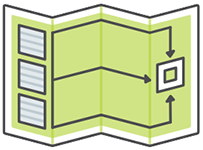 Network Visualization
Network Visualization
Nutanix Enterprise Cloud gives IT teams an application-centric visualization of the physical and virtual network topology, providing at-a-glance insight into server, virtualization and storage resources.
- VM Level View
Visually understand how individual virtual machines (VMs) are connected to the network infrastructure to better identify and triage network issues. - Deep Analytics
Get detailed health and performance statistics of the network environment to better monitor application SLAs. - Application Visualization
Visualize the communication between VMs in your applications. Take the mystery out of network policy creation.
 Network Security
Network Security
Applications running on Nutanix can be protected from network security threats with advanced microsegmentation services. Nutanix delivers native VM microsegmentation in addition to supporting integration with services available from multiple Nutanix Elevate Technology partners.
- Centralized Policy
One single point of control for all east-west VM communication. - Application-Centric
Policy is decoupled from networking attributes. Enforcement follows VM and applications. - Flow Visualization
Easily see existing network flows between VMs and applications. - Service Chaining
Support for third party security vendor service insertion between VMs. - Zoning and Ring Fencing
Create isolation or restricted zones of communications. - Quarantine
Preconfigured quarantine policies for manual or automated containment.
Network Orchestration
Acropolis includes open APIs that enable network devices and services such as top-of-rack switches, application delivery controllers and firewalls to automatically adapt based on application lifecycle events.
Acropolis Security
Defense in depth through a security-first approach
The Nutanix Enterprise Cloud Platform combines powerful security features, including role based access control (RBAC), two-factor authentication, Application Security from VM microsegmentation, and FIPS compliant data at rest encryption, with a Security Development Lifecycle (SecDL) that is integrated into product development. Increase your security posture and reduce threats with a self-healing security configuration baseline that exceeds the requirements of the U.S. Department of Defense.
Security Standards and Certifications
Our SecDL process is based on multiple security standards and validation programs. It complies with the strictest international standards, including the SP800-53 guidelines, to assure governments worldwide that Nutanix products perform as expected and work with their existing technology.
![]()
Platform
Nutanix uses a unique Security Development Lifecycle (SecDL) to incorporate security into every step of the software development process, from design and development to testing and hardening. The Nutanix solution is certified across a broad set of evaluation programs for government, financial services and healthcare to ensure compliance.
Security Development Lifecycle
- SecDL Integration
Security is incorporated into every step of the product development lifecycle and covers the entire hyperconverged infrastructure stack, including storage, virtualization, and management. - Fully Automated Testing
SecDL testing is fully automated during development and all security-related code modifications are timed during minor releases to minimize risk. - Threat Modeling
Threat modeling is used to assess and mitigate customer risk from code changes.
System Level Security
- Two-Factor Authentication
If implemented, logins require a combination of a client certificate and username/password. Administrators can use local accounts built into the Nutanix UI, or use Active Directory. - Native Network Microsegmentation
Nutanix Flow provides native VM microsegmentation and application visibility. Easily visualize and secure applications to increase security posture and prevent the spread of network threats. - Data at Rest Encryption (Hardware)
Nutanix encrypts user and application data to a level of FIPS 140-2 Level 2 compliance through factory-installed self-encrypting drives (SED), and meets HIPAA, PCI DSS and SOX standards. - Data at Rest Encryption (Software)
Nutanix encrypts user and application data to a level of FIPS 140-2 Level 1 compliance through the use of standard drives and software based encyrption, and meets HIPAA, PCI DSS and SOX standards. - Power Failure Safeguards
In the event of a power cycle or host reboot, Nutanix software retrieves the keys from the key management server and uses them to unlock the drives. - Key Administration
Instantly reprogram security keys to meet site-specific policies, or use Crypto Erase to instantly erase all data on the drive while generating a new symmetric encryption key. - Industry Compatibility
Rather than storing keys on the nodes themselves, Nutanix software interfaces with third-party key management servers using the industry-standard Key Management Interface Protocol (KMIP). - Cluster Lockdown
Administrators can restrict access to a Nutanix cluster in security-conscious environments, disabling interactive shell logins automatically and leveraging non-repudiated SSH keys.
 Automation
Automation
Powerful automation and self-healing security models help maintain continuous security in enterprise cloud environments with efficiency and ease. Nutanix developed our own Security Technical Implementation Guide (STIG) to speed up the accreditation process for the Department of Defense Information Assurance Certification and Accreditation Process (DIACAP) and the Department of Defense Information Assurance Risk Management Framework (DIARMF).
- Fast Baseline Checks and Validation
The Nutanix STIGs are written in XCCDF format and support the SCAP standard for compatibility with automated assessment tools like HBSS, cutting down accreditation time. - Automatic Configuration Management
Security configuration management automation (SCMA) efficiently checks over 800 security entities in the Nutanix STIGs that cover both storage and built-in virtualization. - Self-Healing
Nutanix leverages SaltStack and SCMA to self-heal any deviation from the security baseline configuration of the OS and hypervisor to remain in compliance.
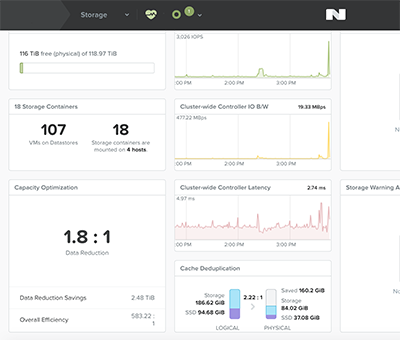 Storage Services:
Storage Services:
Enterprise Storage Capabilities
Scalable, resilient and high performance storage
Enterprise data storage as an on-demand service
The Nutanix Enterprise Cloud Platform eliminates the need for traditional SAN and NAS solutions by employing a highly distributed software architecture. It delivers a rich set of software-defined services that are entirely VM-centric, including snapshots, high availability, disaster recovery, deduplication and more.
Performance Acceleration
Nutanix web-scale solutions employ a variety of advanced mechanisms to drive the highest possible performance for a wide range of virtualized workloads. Powerful acceleration capabilities such as caching, automatic data tiering and data locality speed storage performance. Server-attached flash storage is used both as a high-performance read cache, as well as a persistent data tier in a Nutanix hyperconverged system.
Intelligent Distributed Data Tiering
- Automatic Optimization
Application and user data is automatically placed in the optimal storage tier – flash or HDD – to yield the fastest performance and optimize capacity in the cluster. - Hot Data
The most frequently accessed data (“hot” data) is placed in the SSD or cache tier for near instantaneous access by VMs. - Cold Data
As data becomes “cold,’”it is demoted into the higher capacity HDD tier for more efficient storage, so that SSD and cache capacity remains available for new “hot” data. - Data Placement Management
MapReduce technology manages data placement as a distributed, background process to ensure negligible impact to real-time performance. - Heterogeneous Cluster
Support for heterogeneous cluster that includes Hybrid, all flash, and compute heavy nodes.
Data Localization
- Localized Write I/O
Data stays proximate to the VM and allows write I/O operations to be localized on that same node. - Continuous Analysis
Each Nutanix Controller VM (CVM) continually analyzes whether I/O requests are satisfied by storage resources local on that node, or from another node in the cluster. - Transparent Migration
If a VM migrates to another host for load balancing in an active migration scenario, hot data automatically follows the VM to maintain the highest performance. - Intelligent Migration
After a certain number of read requests made by a VM to a controller that resides on another node, Nutanix data localization moves the remote data to the local controller. - Data Localization Management
Data localization is managed as a MapReduce job to take full advantage of all cluster resources and not impact system performance.
Datapath Optimization
- AHV Turbo
New optimized datapath for AHV IO. No VM reconfiguration required (single SCSI adapter). - Range of I/O Sizes
End-to-end support for I/O sizes from 512 bytes up to 1 MB ensures optimal performance across a wide range of workloads and delivers application-tuned metadata efficiency. - Variable Lengths
Unlike traditional storage systems that break up incoming I/O requests into fixed 4KB chunks, Nutanix efficiently handles block sizes of variable length across the entire write path.
Next Generation Platform Support
- RDMA Support
Support of RDMA in node to node replication paths. Optimized CVM-CVM communications to benefit all NDFS storage operations. - NVMe Support
Support for low latency and high performance NVMe SSD drives. - AHV vGPUs
Enable better desktop experience for VDI by supporting nVidia vGPUs: Tesla M10 & M60.
Resiliency
The Nutanix platform is fault resistant, with no single point of failure and no bottlenecks. A shared-nothing architecture – where all data, metadata and services are distributed to all nodes within the cluster – is built to detect, isolate and recover from failures anywhere in the system for an always-on operation.
Availability Domains
- Intelligent Data Placement
Intelligent data placement across different physical domains (e.g., separate racks or power sources) protects against appliance and rack failures. - Robust Protection
Availability domains allow Nutanix clusters to survive the failure of multiple servers in a physical enclosure without loss to data or service, providing greater system-level resilience without increasing storage capacity. - 100% Software-defined Flexibility
Administrators can configure and manage availability domains at the storage container level in clusters with five or more nodes.
Tunable Redundancy
- User-defined Resilience
Administrators can configure data redundancy based on application SLAs and the criticality of the data set, with a replication factor (RF) of two or three. - Automatic Data Reconstruction
If a node fails, data is automatically read from other nodes. If the node does not come back online, all data on the affected node is automatically reconstructed to ensure full redundancy and data protection. - Synchronous Replication
Data is written to a VM’s local node and is synchronously replicated to one or more other nodes in the cluster, ensuring that all data exists in at least two independent locations and remains highly available.
Datapath Redundancy
- High Availability During Controller VM Unavailability
Multiple copies of data ensure 100% data availability in the event that a Nutanix Controller VM is unavailable due to failure or maintenance. - Transparent Failover
If the Nutanix Controller VM becomes unavailable, Nutanix auto-pathing automatically re-routes requests to a healthy Controller VM running on another node in the cluster. - Fault-tolerant Architecture
Every node in a Nutanix cluster has access to all replicas so that I/O requests can be serviced immediately by any node, providing N-way, fully fault-tolerant failover for all VMs in the cluster.
Data Integrity Checks
- Detection and Repair of Silent Data Corruption
The system scans data in the background and checks against checksums in the metadata store. If it detects an error, it will overwrite the bad data with the good copy. - Automatic Integrity Checks
On every read, a checksum is computed for the data being read and compared with the stored checksum. In the case of an inconsistency, the error is corrected. - Automatic Isolation and Recovery
If a drive fails, the system automatically runs a scan and replicates any data that is not redundant. During the failure and recovery process, both data and access to data are preserved.
Deduplication
- Performance Tier Deduplication
Removes duplicate data in the content cache (SSD and memory) to reduce the footprint of an application’s working set, enabling more working data to be managed in the content cache for better performance. - Capacity Tier Deduplication
Global, post-process MapReduce deduplication reduces repetitive data in the capacity tier to increase the effective storage capacity of a cluster. - Simplified Management
Easily configured and managed at vdisk granularity for fine-grained control.
Compression
- Increase Capacity by up to 4x
Data compression can be enabled as an inline capability as data is written to the system, or post-process as a series of MapReduce jobs after the data has been written, eliminating any impact on write path performance. - Leverage All Resources
Unlike traditional architectures where compression operations run on one or two CPUs, Nutanix compression runs on each node in the cluster to leverage all system compute and memory resources. - Compress a Variety of Data Types
Nutanix uses the Snappy compression algorithm to compress a variety of data types more efficiently, and includes the option to compress data at the sub-block level for greater simplicity.
Erasure Coding with Nutanix EC-X
- Resilience with Capacity Efficiency
A mathematical function is applied around a data set to calculate parity blocks, which can then be used to recover data in the event of a failure. - Optimized Performance
Nutanix systems switch between data replication for hot data and erasure coding for cold data based on I/O frequency to optimize performance and storage. - Nutanix EC-X
This patent-pending algorithm distributes coding and rebuilds across the entire cluster to reduce vulnerability windows in the event of failures, and maintains data locality.
Clones
Improve performance with distributed caching of VM data for linked clones, redirect-on-write snapshots and writeable clones at the granularity of a single VM.
Snapshots & Clones
- Near Zero Performance Impact
Redirect-on-write snapshots and writeable clones at the VM level increase efficiency, while differential forever snapshots impose lower capacity overheads on the system. - Fine-grained Data Management
Unlike systems that snapshot data at a volume or LUN level, Nutanix snapshots and clones are performed for individual VMs for fine-grained data management and protection. - Easy Clone Creation
Create clones (writeable snapshots) of a base image in seconds, leveraging integration with popular offload capabilities, including the VMware API for Array Integration (VAAI), Microsoft Offloaded Data Transfer (ODX) and SMI-s.
Shadow Clones
- Unique Nutanix Feature
Shadow Clones are a unique Nutanix feature that significantly improves performance by caching virtual machine data across a Nutanix cluster. - Ideal for Multi-reader Scenarios
Gain performance where there are multiple VMs reading a single source of data, or in VDI deployments with linked clones (e.g., Citrix MCS Master VM or VMware View replica disks). - vDisk Access Trend Monitoring
If read I/O requests originate from more than two remote Controller VMs (CVMs) and the local CVM, the vDisk is marked as immutable and cached locally, so read operations are satisfied by direct-attached storage resources.
VM Storage
Efficient, high-performance, and enterprise-grade VM storage
What is VM Storage?
Acropolis provides enterprise-grade VM-centric storage for virtualized applications. Unlike traditional storage solutions that were built in a pre-virtualization era, operations in Acropolis are optimized to work at a granularity of a single VM or vDisk. Additionally, complex storage operations such as LUN provisioning, zoning and masking are non-existent in Acropolis enabling deployment of highly available storage with just a few clicks.
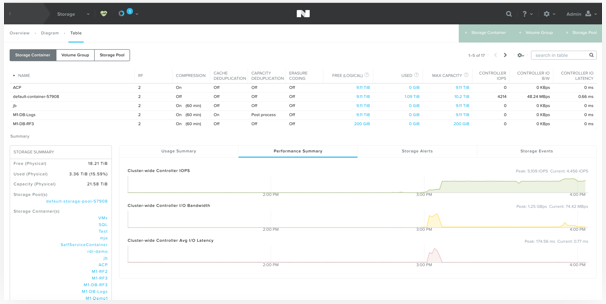
High Performance for all Workloads
Choice and Flexibility Support for a wide range of hypervisors including Nutanix AHV, VMware vSphere and Microsoft Hyper-V with native hybrid-cloud connectivity to AWS and Microsoft Azure.
- Deploy VM-centric Storage in Seconds
No more storage complexity, no more LUN provisioning. Give the VM datastore a name, set data redundancy levels, enable capacity optimization policies and you are done. - High Performance for all Workloads
Choice and Flexibility Support for a wide range of hypervisors including Nutanix AHV, VMware vSphere and Microsoft Hyper-V with native hybrid-cloud connectivity to AWS and Microsoft Azure. - Choice and Flexibility
Support for a wide range of hypervisors including Nutanix AHV, VMware vSphere and Microsoft Hyper-V with native hybrid-cloud connectivity to AWS and Microsoft Azure.
Data Localization
- Localized Write I/O
Data stays proximate to the VM and allows write I/O operations to be localized on that same node. - Continuous Analysis
Each Nutanix Controller VM (CVM) continually analyzes whether I/O requests are satisfied by storage resources local on that node, or from another node in the cluster. - Transparent Migration
If a VM migrates to another host for load balancing in an active migration scenario, hot data automatically follows the VM to maintain the highest performance. - Intelligent Migration
After a certain number of read requests made by a VM to a controller that resides on another node, Nutanix data localization moves the remote data to the local controller. - Data Localization Management
Data localization is managed as a MapReduce job to take full advantage of all cluster resources and not impact system performance.
Shadow Clones
Nutanix Shadow Clones are a unique feature of the Nutanix Virtual Computing Platform that allows for consistent performance at scale of large VDI and Multi-reader scenarios with VMs sitting on different hosts.
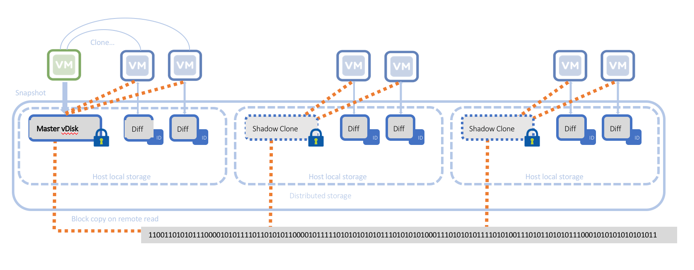
Acropolis File Services
Simple, scalable and reliable file storage for your enterprise cloud
What is AFS
Acropolis File Services (AFS) is a software-defined scale-out file storage solution for unstructured file data. It provides a highly available and massively scalable data repository for a wide range of deployments and applications. AFS is natively integrated into the Nutanix Enterprise Cloud OS, and it precludes the need for a separate NAS appliance by providing a consolidated solution with unified management for VM and file services.
- Eliminate Complexity
VM and file storage are on the same cluster, eliminating the complexity of deploying and managing a separate infrastructure stack for standalone NAS solutions. - Scale on Demand
AFS is a 100% software-based service that can be deployed in minutes and scaled on demand with a single click. - Easily Grow Capacity
Storage can be scaled independently of compute. A storage heavy or storage only Nutanix node can be added to the cluster, and additional file server VMs can be deployed instantaneously. - Ensure Availability
AFS makes sure data is available during software upgrades, hardware upgrades and unexpected failures with no bottlenecks or isolated points of failure. - Protect and Recover Files
Native snapshots and self-service recovery make recovery of files extremely easy. - Leverage Flexible Deployment Options
AFS can be deployed on stand-alone clusters purely meant for file serving or integrated where virtual machines and data live in the same cluster.
Scale up or Scale out on demand easily and invisibly
AFS allows you to easily scale from 100s of users to 10s of thousands of users enabling you to store billions of files and PBs of data.
- Turnkey Consolidation
Can be deployed standalone for centralized management of file data or on an existing Nutanix cluster for better cluster utilization. - Single Namespace
A single namespace is exported from the AFS cluster, no matter how large the cluster is. - Scale and Performance
Built to handle billions of files by design, and tens of thousands of user sessions. As the environment grows, the cluster can be scaled up or scaled out. - Enterprise Storage
Features Includes intelligent tiering, deduplication, erasure coding, and compression from DSF.
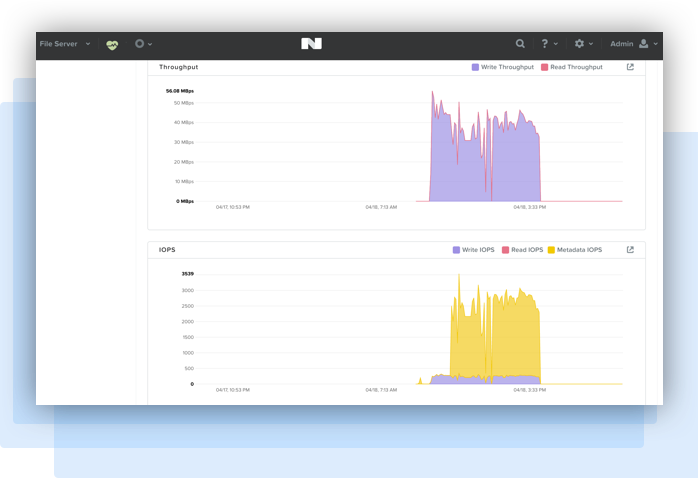
Container Storage
Enterprise class, persistent storage for containers
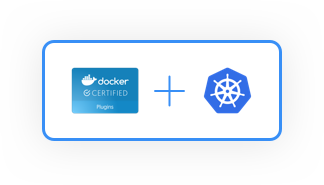 What is Container Storage?
What is Container Storage?
Nutanix Container Storage Services delivers enterprise features such as resiliency, availability, disaster recovery, and capacity optimization for both Docker and Kubernetes leveraging Acropolis Block Storage Services (ABS).
- Persistent, Resilient Storage
Persistent container volumes provide resilient storage for containerized stateful applications such as databases and web caches. - Container Plus Virtualized Applications
A common platform that supports both virtualized and containerized environments allows DevOps to pick the best technology for their needs without creating infrastructure silos. - Acropolis DSF Benefits
Persistent container volumes are backed by iSCSI block storage on the Acropolis Distributed Storage Fabric (DSF) with all the benefits of deduplication, compression, tiering and erasure coding.
 Nutanix Kubernetes External Provisioner
Nutanix Kubernetes External Provisioner
Nutanix provides a Kubernetes External Storage Provisioner that leverages Nutanix ABS (Acropolis Block Service) to dynamically provision, create, delete container volumes for stateful workloads.
Bridging the worlds of physical and virtual
ABS eliminates infrastructure silos by delivering the same simplicity Nutanix offers for virtualized workloads and file storage for physical workloads. In so doing, ABS bridges the physical and virtual worlds, consolidating infrastructure into a single unified platform.
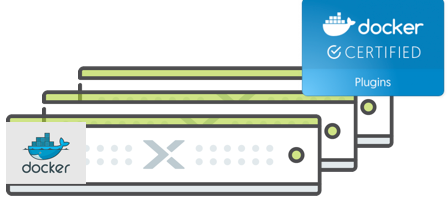
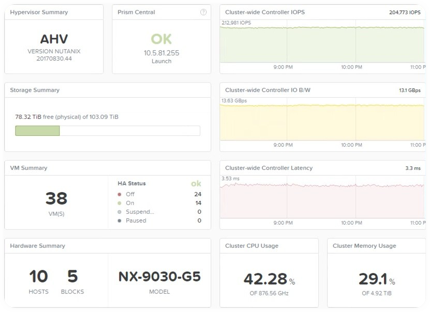 Acropolis Block Services
Acropolis Block Services
A native scale-out block storage solution
Acropolis Block Services (ABS) is a native scale-out block storage solution that provides direct block-level access via the iSCSI protocol to the Acropolis Distributed Storage Fabric (ADSF). It enables enterprise applications running on external servers to leverage the benefits of the hyperconverged Nutanix architecture.
- Protect Existing Investments
Connect storage with database environments such as Oracle, SQL Server and SAP that are deployed on specialized physical servers for price/performance or on bare-metal x86 to minimize software licensing costs. - Lower Costs
Eliminate the need for traditional Fibre Channel SANs and other specialized products that drive costs higher and require specialized IT administrators to maintain. - Deliver Performance
Ideal for non-virtualized, high-performance database applications – if a single Nutanix CVM can deliver 100,000 IOPS, a four-node Nutanix cluster can deliver an aggregated throughput of 400,000 IOPS. - Simplify Management
The platform is simple, scalable, and enterprise-grade out of the box, and can easily be managed by IT generalists from within Prism. - Leverage Hyperconverged Benefits
ABS delivers all the benefits of a hyperconverged environment, including intelligent data reduction, advanced disaster recovery, backup to the public cloud, and tiering capabilities.
Bridging the worlds of physical and virtual
ABS eliminates infrastructure silos by delivering the same simplicity Nutanix offers for virtualized workloads and file storage for physical workloads. In so doing, ABS bridges the physical and virtual worlds, consolidating infrastructure into a single unified platform.
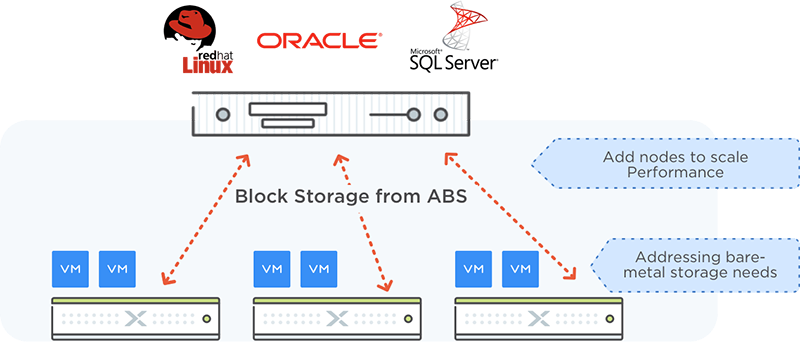
Nutanix manages storage allocation and assignment for ABS through Volume Groups (VG). A VG is a collection of volumes known as virtual disks (vdisks). ABS presents VGs to both VMs and physical servers as iSCSI LUNs and managed by Prism.
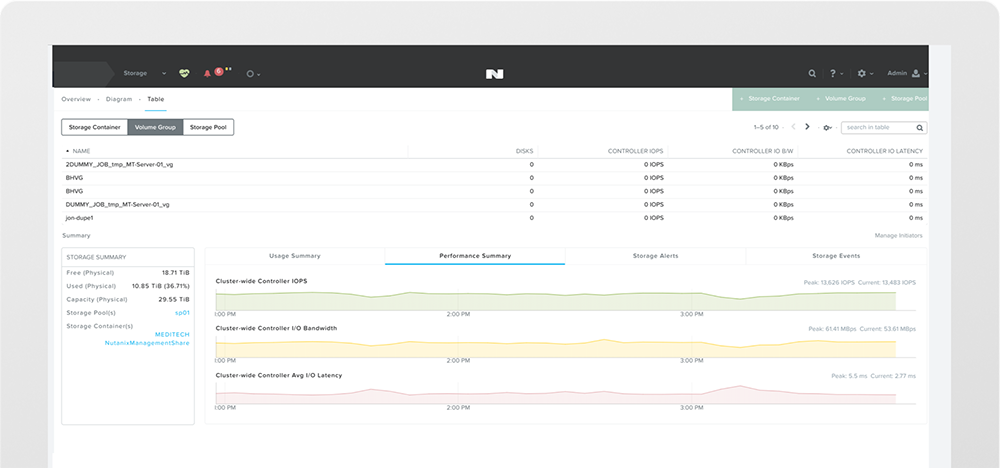
Documentation:
Download the Nutanix Acropolis Datasheet (.PDF)
